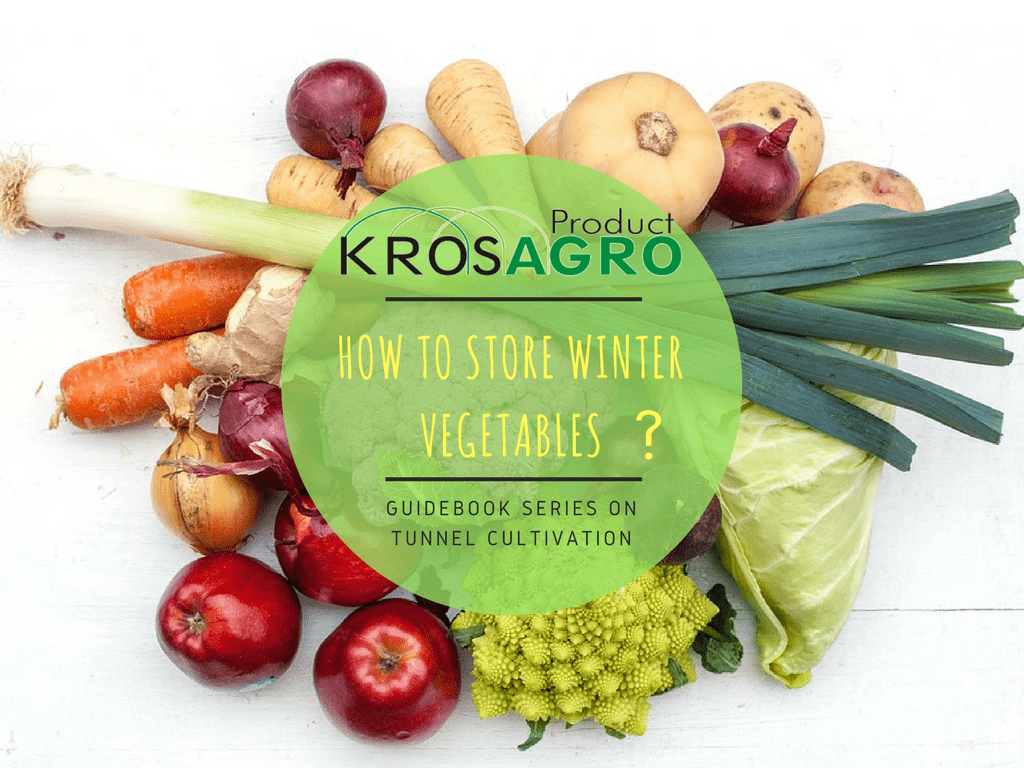In autumn, gardening slows down, fruits and vegetables in winter reach fully maturity and the polytunnel itself gets ready for winter. These are the last moments for growers to enjoy their hobby, before saying goodbye to colorful and aromatic flowers and plants. At the same time, cellars or basements are slowly getting filled with products for long conservation. Proper storage of crops significantly extend their shelf life. You can then enjoy the rewards of your efforts for much longer.
Contents
Factors affecting shelf-life of vegetables
The first and most important factor is the health of vegetables in winter. It is essential to harvest them fresh, undamaged and not infected by pests.
Soil fertilization in excess, especially nitrogen, affects conservation of some vegetables, accelerating the rotting process. Care should be taken when fertilizing in order to keep a low level of those elements.
Long lasting species are much better and more resistant to storage.
Conditions for stored vegetables in winter
Temperature and humidity are the two main factors affecting quality of vegetables and their state during storage. The optimal storage temperature is a stable 0 ° C. But it can not fall or rise sharply as vegetables can then develop roots and leaves.
Garlic and onions are effectively stored with temperatures between 1 and 7 ° C and low humidity. They can often be found in ventilated and frost-free rooms. They are bound in a braid and spread over a layer of straw. Before proceeding with such a storage, the crop should be dried so mold and fungus do not affect it.
Root vegetables (potatoes, beetroots, carrots, etc.) are stored with a higher humidity and temperatures between 1 and 4 ° C.
Sand dipping
To extend vegetables’ shelf-life for consumption, dipping them in sand can be performed to prevent them from drying out. From time to time, such a layer is gently sprayed with water. First remove stems from the vegetables and then place them in a box allowing space between them. Potatoes, beetroots and celery are kept in bags to let them breathe.
Adding apples to potatoes is an effective practice to reduce their germination. You need to control the quality of your vegetables. Those that are bruised should be removed and only healthy specimens should be kept.
Which vegetables can be stored in winter?
In this case, it is quite important to determine what type of vegetable you are dealing with. Some of them need specific conditions, more or less humidity or a different temperature. Tomatoes, cauliflowers, cucumbers and radishes are, for example, plants that can only be kept for about two weeks. Quite simply, leaf and stem vegetables are very short-lived, and are not suitable for consumption after a few days. On the other hand, beetroots, onions, garlic, celery and cabbage can be stored for a long time.
Are there varieties of vegetables more suited for storage?
Of course! Their main feature is that they are available for consumption much longer than ordinary varieties. On the market, you can find many seeds and seedlings with the right properties. With regard to early varieties, they are not suitable for storage as they age much faster.
When to harvest vegetables for storage?
As previously mentioned, it is established that harvest has a major influence on plants’ consumption time. You can store mature plants for long periods, but not the overripe ones.
Growing term plays a significant role especially in the case of onions and garlic, while in terms of storing, the sowing date is more important for beetroot, carrot and parsley.
Harvest should be done during dry days when soil is not too damp. Before being transferred to the storage facility, crops must be thoroughly cleaned and inspected. Only undamaged and healthy plants can be stored.
Vegetable storage methods
- Mound stock
When excess yield and lack of space combine, the solution is to store in mounds. Carrots, celery and parsley are placed into deep narrow ditches (width 50 cm, depth 60 cm), while cabbage and beetroot can rest in shallower pockets (20 cm). A thin layer of sand is sprinkled over the ditches , the ground is covered with earth, then the whole pile must be flattened down. As frost occurs, extra few layers are added or agro textile is used to cover.
- In the ground
Frost-resistant plants can be left in the ground for winter. But by leaving them in, we do not give soil any time to rest and regenerate after the growing season. When winter comes and before frost appears, they can be stored underground. For this purpose, a groove is dug to a depth of 15 cm, and covered with agro textile. The ground is then covered with sand.
- In the polytunnel
This requires reorganizing the gardening greenhouse. Just set up shelves and tables to create space for storing vegetables.
